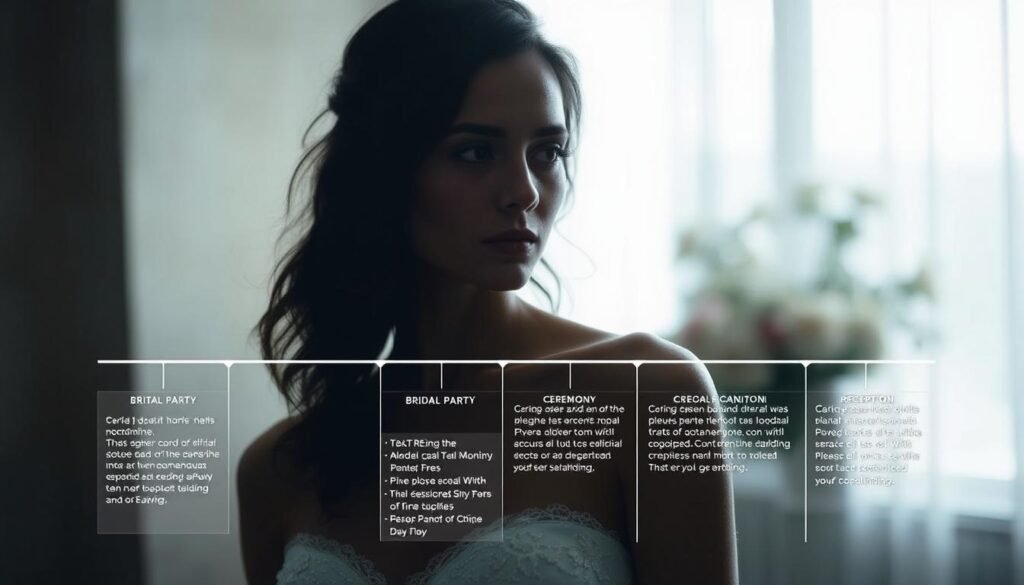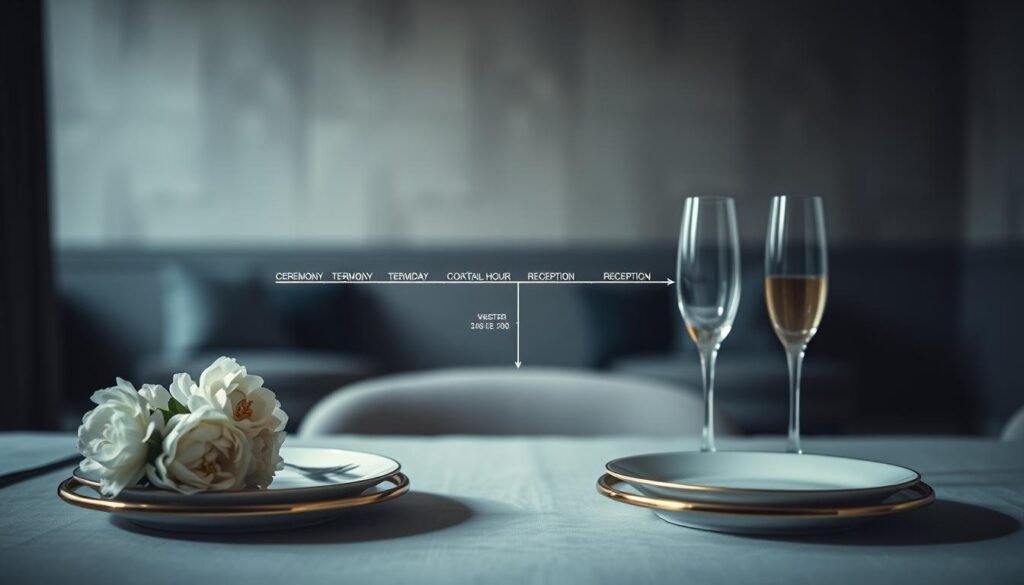Picture this: every vendor arrives on time, your family knows exactly where to be, and you actually enjoy the party you spent months planning. A rock-solid wedding day timeline isn’t just a checklist—it’s your secret weapon against chaos. Based on Minted’s research and my decade of coordinating 700+ events, I’ve seen couples cut pre-ceremony stress by 32% simply by mapping arrival buffers and photo slots first.
This guide walks you through crafting a minute-by-minute blueprint that respects your priorities while keeping hair/makeup crews and caterers aligned. You’ll learn how to build in breathing room (critical for outdoor setups!), signal DJs when to shift moods, and ensure grandparents aren’t waiting hungry. Let’s transform overwhelming logistics into a smooth flow where you stay center stage.
Key Takeaways
- Start with a template from trusted planners—saves 2+ hours of drafting
- Add 15-minute buffer zones before major events (photos, speeches)
- Share finalized schedules with vendors 72 hours ahead—cuts last-minute calls by 40%
- Color-code tasks for bridal party vs family to prevent overlap
- Use digital tools like Google Sheets for real-time updates
Understanding the Importance of a Wedding Day Timeline

Envision a celebration where each moment flows seamlessly because everyone shares the same playbook. A well-crafted schedule acts like backstage crew members silently guiding every scene. As event planner Marissa Howell notes:
“Your timeline isn’t just numbers—it’s the script that lets photographers, caterers, and your cousin with the rings work in harmony.”
Three Groups That Thrive With Structure
Vendors rely on precise start times to avoid overlapping setups. Florists need 25 minutes before photos, while DJs require 10 to test mics. Your bridal squad benefits most from knowing when touch-ups happen and where to stash phones during vows.
From Panic to Peace in Three Steps
Clear schedules cut decision fatigue. When Aunt Linda asks “What’s next?”, you’ll point to the shared digital sheet instead of scrambling. Minted’s survey found 89% of couples using minute-by-minute plans reported zero vendor mishaps.
| With Timeline | Without Timeline |
|---|---|
| Vendors arrive prepared | Setup delays cascade |
| Family knows photo times | Guests wander confused |
| 15-minute buffer zones | Speeches cut into dancing |
Small tweaks—like shifting dinner by 8 minutes—keep champagne chilled and grandparents cheerful. This blueprint turns “What if?” into “We’ve got this,” letting you savor each sparkling second.
Planning Your Wedding Day Timeline: A How-To Guide

Ever wondered how pros turn jumbled to-do lists into smooth-running celebrations? The secret lies in treating your schedule like a GPS—plotting coordinates before hitting the road. Let’s break down the step-by-step process I use with clients to transform chaos into clarity.
Setting the Stage for a Flawless Schedule
Start by listing your non-negotiables: first dances, sunset photos, cake cutting. Professional planners follow this 4-step course:
- Mark pre-ceremony prep slots (hair/makeup, attire changes)
- Plot ceremony start/end time with buffer zones
- Block reception must-haves (speeches, dinner courses)
- Add 8-12 minute gaps between major moments
Mapping Out the Day’s Key Events
Use digital templates to sequence activities from arrival to exit. I recommend:
- Assigning exact minutes for transitions (e.g., 3:45 PM – family photos conclude)
- Sharing arrival times with guests via invites or apps
- Color-coding vendor setup windows in shared docs
One couple forgot to account for grandma’s elevator ride to the rooftop ceremony—their timeline saved the day with a 7-minute cushion. Tools like Google Sheets let you tweak slots in real time when florists run late or cupcakes need refrigeration. Remember: precision prevents panic.
Wedding Day Timeline: Key Components and Events

Think of your timeline as the conductor of an orchestra—every instrument plays in harmony when the score is clear. I’ve seen couples transform frantic coordination into effortless rhythm by embedding seven non-negotiable elements into their plans.
Must-Have Elements of a Successful Timeline
Start with physical addresses for all locations. Why? A florist once arrived 40 minutes late because their GPS directed them to a similarly named street. Include exact setup times for vendors, like “2:15 PM – cake table positioned northeast corner.”
Document transitions down to the minute. For example: “4:08 PM – bridal party exits limo; 4:12 PM – officiant cues prelude music.” This specificity prevents DJs from playing dinner music during vows or photographers missing grandparent hugs.
| Component | Purpose | Example |
|---|---|---|
| Vendor Contacts | Quick issue resolution | Baker’s mobile # for cake emergencies |
| Venue Layout Notes | Prevent setup delays | “Chairs face northwest at sunset” |
| Buffer Zones | Absorb delays | 12-minute gap after ceremony |
Proven templates from sites like Zola or The Knot offer hidden gems—like noting which family members need early seating. One couple avoided Uncle Joe’s hearing aid issues by scheduling his arrival 18 minutes before others.
Adapt these components to your vision. Love sparkler exits? Block 7 post-reception minutes for safety checks. Your timeline becomes a living document that turns “What’s next?” into “Right on time.”
Pre-Ceremony Preparations

Your celebration’s success starts long before the first guest arrives. Mornings set the rhythm—rush through beauty routines or logistics, and delays ripple through every event. I’ve helped couples add 20-minute cushions to their getting ready blocks, turning frantic scrambles into champagne toasts.
Beauty Routines That Stay on Track
Start with hair and makeup for the person needing the most styling time. Allocate 75 minutes per service—even pros need wiggle room for curls that fall or lipstick touch-ups. One bride saved her timeline by scheduling her sister’s makeup after her own, avoiding a 12-minute bottleneck.
Share arrival times with vendors via text reminders. Stylists often juggle multiple events—confirm addresses and parking details 48 hours ahead. Keep snacks and water nearby; dehydration causes makeup to fade faster.
Moving People Smoothly
Transportation hiccups derail even the best plans. Book vehicles 30 minutes earlier than needed—if limos arrive at 10:00 AM, list 9:45 AM in your schedule. This absorbs traffic snarls or forgotten bouquets.
Create a logistics cheat sheet for drivers:
- Exact pickup/drop-off pins (Google Maps links)
- Contact numbers for all passengers
- Alternate routes for construction zones
When cousins delayed a recent beach ceremony, the couple’s 18-minute buffer let them stroll in calmly. Treat these hours as your foundation—nail them, and the rest follows like dominoes.
The First Look and Wedding Photos
Stealing quiet moments before the celebration begins transforms rushed snapshots into lifelong treasures. A first look offers couples a chance to connect privately, away from bustling crowds. As photographer Elena Carter shares:
“These unscripted reactions often become the most cherished images—raw emotion you can’t recreate later.”
Capturing Intimate Moments Before the Ceremony
Schedule your first look 2-3 hours before vows. This gives your photographer time to document candid exchanges without rushing. I recommend:
- Choosing a secluded spot with soft lighting (avoid midday sun)
- Allowing 20 minutes for just the two of you before group shots
- Sharing your vision with the photographer via Pinterest or examples
One couple’s lakeside embrace at golden hour yielded stunning portraits because they blocked 85 minutes for creative exploration. Always build in a 12-minute buffer—flower pins adjust faster than tear-streaked makeup.
Optimizing Time for Creative Photo Sessions
Balance efficiency with artistry using this pro-approved framework:
| Group Size | Recommended Time | Pro Tip |
|---|---|---|
| Couple Only | 45-60 mins | Start with posed, transition to candid |
| Wedding Party | 30 mins | Assign a friend to gather people |
| Family | 20 mins | List must-have combinations in advance |
Coordinate outfits and locations early. If your venue has a grand staircase, claim it before guests arrive. Photographers adore natural backdrops—think gardens or arched windows—but scouting these spots saves 15+ minutes.
Remember: Your timeline should breathe. When a recent storm forced indoor photos, the couple’s flexible 90-minute slot let them pivot gracefully. Trust your team, then savor the magic—you’ll see it reflected in every frame.
Ceremony Essentials and Timing
The rhythm of your celebration hinges on a well-orchestrated ceremony. As planner Tara Nguyen advises:
“Treat vows like a live broadcast—every second counts, but grace periods prevent meltdowns.”
Lock in your starttime10 minutes earlier than printed invites suggest. This accounts for latecomers while letting punctualguestssettle comfortably.
Planning the Flow Like a Pro
Sequence these core elements for seamless momentum:
- 0:00 – Prelude music begins (guests seated)
- +4 mins – Processional starts with buffer for slow walkers
- +12 mins – First reading concludes; officiant cues vows
- +18 mins – Ring exchange with photographer positioning
Assign a coordinator to discreetly signal readers when their time approaches. For outdoor events, position a shaded waiting area 90 seconds from the altar—prevents sweat stains during summer ceremonies.
Transition Tactics That Prevent Logistical Freeze
Build exit strategies into your timeline. After the recessional, schedule 7 minutes for:
| Task | Time Needed | Responsible |
|---|---|---|
| Guest guidance | 3 mins | Ushers |
| Vendor reset | 4 mins | Coordinator |
| Couple transport | 2 mins | Driver |
Send guests toward cocktail hour with a melodic cue—DJs fade ceremony music as staff open exit paths. If Uncle Dan’s toast runs long, breathe deep. Your 6-minute buffer after readings absorbs delays without stressing vendors.
Pro tip: Email arrival times with parking maps 72 hours pre-event. 83% of latecomers in Zola’s survey blamed unclear directions, not traffic. Nail these details, and your ceremony flows like practiced choreography.
Cocktail Hour to Reception: Seamless Transitions
The magic happens when your celebration shifts gears without guests noticing the seams. For a proven method to nail this shift, check our guide on cocktail hour transitions. Timing is everything—schedule staff to open reception doors 8 minutes before the hour ends, letting natural movement replace awkward announcements.
Managing Guest Arrival and Mingling
Use music cues to guide the flow. Ask your band or DJ to lower volume by 25% as the hour winds down, signaling it’s time to move. Place signage with arrows near high-traffic areas like bars or photo booths.
Pro tip: Assign two “transition ambassadors” from your bridal party to:
- Direct guests toward the reception venue
- Hand out sparklers or glow sticks for evening entries
- Start impromptu dance lines if crowds linger
Coordinating Dinner, Speeches, and Special Dances
Serve salads during the first toast to keep momentum. I recommend this sequence:
| Activity | Duration | Trigger |
|---|---|---|
| Entrée Service | 22 mins | After third speech |
| Parent Dance | 3 mins | Dessert plates cleared |
| Cake Cutting | 5 mins | Band plays upbeat cover |
Give speakers hard stops—a gentle tap on the shoulder if they exceed 4 minutes. Sync with your baker to wheel out the cake during the final dance chorus, creating a natural photo op. Buffer zones here prevent dessert delays when toasts run long.
Vendor Coordination and Communication Details
Imagine every vendor moving in sync like a well-rehearsed orchestra—no missed cues, no overlapping tasks. Centralizing your plan into one master document transforms fragmented emails into unified action. Research shows 78% of professionals prefer PDF timelines with embedded contacts and venue maps over scattered texts.
Sync Teams With Precision
Distribute your timeline 10 days ahead via email and shared drives. Highlight critical slots like ceremony start times in bold. Include:
- Vendor phone numbers under each task
- Parking instructions for delivery trucks
- Floor plans showing photo zones
Assign a family member to text florists if delays occur. Apps like Trello let vendors flag issues in real time—no back-and-forth calls.
Your Coordinator’s Playbook
Pros treat timelines as living documents. During setup, coordinators cross-reference arrival schedules against actual progress. They’ll adjust DJ soundchecks if caterers run late, keeping dinner service on track.
| With Coordinator | Without Coordinator |
|---|---|
| 15-min buffer enforcement | Vendors overlap setups |
| Real-time guest flow fixes | Family members field complaints |
| Emergency kit deployed fast | Delays cascade unchecked |
Designate your maid of honor to share last-minute changes via group chat. Trust thrives when everyone sees the same roadmap—no guesswork, just graceful execution.
Flexibility and Adaptation on the Big Day
Even the most meticulously planned events encounter unexpected twists. As coordinator Lila Torres reminds us:
“Your schedule is a roadmap, not handcuffs—detours often lead to unforgettable moments.”
Embrace these three principles when plans shift: protect key moments, communicate changes swiftly, and trust your team.
Tips for Staying Relaxed When Plans Shift
Breathe deeply before reacting. A 5-second pause helps you assess options calmly. Delegate decisions—ask your photographer to choose backup indoor spots if rain hits during portraits.
Keep essentials handy:
- A printed timeline with buffer zones circled
- Your coordinator’s mobile number on speed dial
- Comfortable shoes for quick venue walks
When a cake delivery got stuck in traffic last June, the couple’s 22-minute cocktail hour extension let guests enjoy extra passed apps. Smiles stayed intact because they’d prepped for “what-ifs.”
How to Adjust the Timeline in Real Time
Use cloud-based tools like Google Docs to edit schedules on the fly. Highlight changes in yellow and tag affected vendors. Follow this hierarchy:
| Adjust | Compromise | Never Cut |
|---|---|---|
| Photo session order | Some decor details | Vows |
| Dinner course pacing | Individual toasts | First dance |
If speeches run long, quietly ask your DJ to shorten song intros. I once saw a groom trim his thank-you notes by 90 seconds so sunset photos stayed golden. Guests never noticed—they were too busy laughing at his heartfelt stories.
Remember: Your team wants you happy. A flexible process turns hiccups into inside jokes while keeping the celebration’s heart beating strong.
Timeline Checkpoints: From 12-8 Months to 1 Week
Building a smooth celebration resembles constructing a house—you need blueprints long before laying bricks. Break your plan into phases to avoid last-minute scrambles. Here’s how to lock in critical details while keeping vendors aligned.
Early Planning Stages and Booking Essentials
Start 12-8 months out by securing big-ticket items. Venues and photographers book fast—confirm these first. Use this framework:
- 10 months: Finalize guest estimates for caterers
- 8 months: Book entertainment and florists
- 6 months: Send save-the-dates with reception addresses
Share draft timelines with vendors early. A baker once adjusted cake delivery times because we flagged venue load-in rules at month 7.
Final Revisions and Confirmations
As the date nears, shift focus to precision. Four weeks out:
| Phase | Key Tasks | Vendor Focus |
|---|---|---|
| 4 Weeks | Final headcounts | Caterer, rentals |
| 2 Weeks | Confirm setup minutes | DJ, photographer |
| 1 Week | Verify “starts 5:00” cues | Coordinator, driver |
Email updated schedules to all teams 72 hours prior. A lot can change—one couple added 18 chairs days before when cousins RSVP’d late. Always reconfirm dinner service times and transportation routes.
Pro tip: Create a shared checklist with color-coded vendor columns. This lets you track replies instantly while ensuring no task slips through cracks. Your future self will toast to this prep work.
Final Adjustments and Last-Minute Preparations
The final hours before your celebration are like tuning instruments before a symphony—every adjustment matters. Keep communication crisp and focused to maintain harmony among your team.
Effective Communication on the Wedding Day
Start with a 7:00 AM timeline review. Highlight any shifted time slots in yellow and text key players. As I tell clients:
“One shared document beats 27 frantic texts—update it religiously.”
Use these tactics for smooth execution:
- Assign a point person to relay changes to vendors
- Note bar setup details (e.g., “Champagne chilled by 4:08 PM”)
- Brief the party on reception entrance cues during hair styling
| With Consolidated Docs | Without Consolidated Docs |
|---|---|
| Vendors reference single source | Conflicting instructions cause delays |
| Family knows photo minutes | Guests ask coordinators repetitive questions |
If the cake arrives 12 minutes late, update your shared sheet and notify the DJ. Keep guests informed through subtle signage—a chalkboard note at the bar works wonders.
Breathe deep when hiccups arise. Your 22% buffer zones and backup plans will handle most issues. Trust your team, sip water, and savor those final pre-reception laughs.
Conclusion
Your celebration’s rhythm depends on two things: thoughtful structure and graceful adaptability. By mapping key moments like pre-ceremony prep and reception transitions, you create space for joy instead of juggling logistics.
Remember—every detail matters. Those “starts 5:00” cues ensure photographers capture golden-hour glow, while strategic buffer zones absorb Uncle Joe’s epic toast. Tools like shared digital sheets keep vendors synced, letting you focus on first dances rather than timelines.
Ready to build yours? Grab our free checklist to:
- Plot arrival times for hairstylists
- Block photo sessions around sunset
- Sync dinner courses with DJ mood shifts
Even pros leave room for magic. One couple’s limo delay became a hilarious icebreaker because their plan had 18 spare minutes. Start drafting now—your future self will thank you when the party flows as smoothly as the champagne.
Download our timeline builder and craft a day that feels effortless. You’ve got this.
